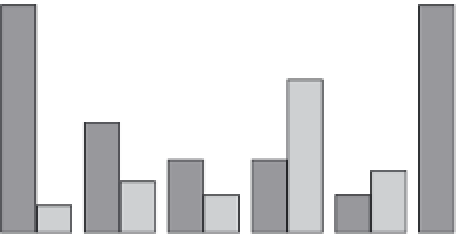Environmental Engineering Reference
In-Depth Information
0.600
Mercury
Total PCB
0.400
0.200
0.000
-0.200
FIGURE 14.1
Mercury and PCB levels in Great Lakes fi sh, by lake source and fi sh species. Error bars denote
2 SD. (
Sources:
Inter-Tribal
Fisheries and Assessment Program (ITFAP), 2003, 2004, 2005.)
hardening of the arteries (Salonen et al., 1995). Several
authors point out that the risk of cardiovascular disease as
it relates to fi sh consumption, therefore, may ultimately be
determined by the balance between omega-3 PUFAs and
mercury in the fi sh consumed (Salonen et al., 1995; Guallar
et al., 2002). Should this prove true, the risk of cardiovascu-
lar disease could range from relatively low in populations
that eat fi sh that are very oily and have minimal mercury
content to relatively high in populations that eat fi sh that
are less oily and have high mercury content. As in the case
of mercury and selenium, this demonstrates the poten-
tial importance of recognizing the specifi c consumption
behaviors and nutrient intake of a particular population
when developing fi sh-consumption guidelines.
Another complicating factor is the possible co-
contamination of fi sh with other chemical pollutants that
can contribute to cancer and other adverse health out-
comes. Polychlorinated biphenyls (PCBs) and dioxins, for
example, are industrial contaminants that can persist in
the environment and are likely carcinogenic. Although lev-
els of these two contaminants are on an overall decline in
the environment because of a ban on PCBs and the reduc-
tion of dioxin emissions, numerous studies document their
presence in fi sh (Flint and Vena, 1991; Gerstenberger and
Dellinger, 2002; Mozaffarian and Rimm, 2006; Stahl et al., 2009)
as well as in fi sh consumers and their offspring (Falk, et al.,
1999; Hanrahan et al., 1999; Stewart et al., 1999; Schaeffer et
al., 2006). Meanwhile, various emerging contaminants appear
to be on the rise in fi sh, including polybrominated diphenyl
ethers (PBDEs), polychlorinated diphenyl ethers (PCDEs), and
polychlorinated naphthalenes (PCNs). Knowledge of the health
effects of these contaminants is currently limited (Domingo
et al., 2007). Co-contaminants like those mentioned here can
confound the adverse effects of mercury in fi sh.
A separate but related issue is the fact that the levels of
mercury and co-contaminants in fi sh do not necessarily
vary together (Figure 14.1). In other words, a fi sh that is
relatively low in mercury can be relatively high in another
type of contaminant. This leads to an important point: to
truly protect human health, fi sh-consumption guidelines
cannot be created in isolation, only with mercury (and its
interaction with factors like selenium) considered. Instead,
effective guidelines must consider the comprehensive risks
of mercury
and
other contaminants in fi sh.
Guidelines for Fish Consumption
Fish Advisories in the United States
The fi sh that people consume generally fall into one of
two categories: (1) noncommercial fi sh caught for sport or
subsistence from local sources, and (2) commercial fi sh,










































































